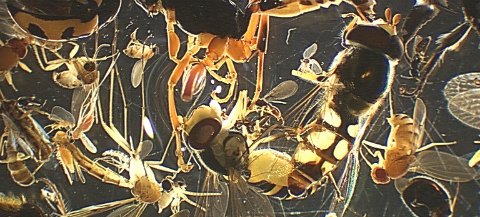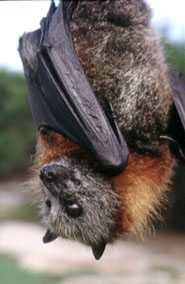Home | About CCW | Contact Us | Climate change Meaning | Causes | Solutions | Emissions | Carbon trading
Plant pests
Plant pests are, by definition, a nuisance. They are the insects, bugs and fungi that live off plant tissue in ways that either affect plant growth or spoil the parts of the plant we want to use.
There is nothing worse than finding a maggot in your lunchtime apple, except perhaps half a maggot. Whitefly on the cabbages takes all the pleasure out of growing your own and there is not much to be done about rust.
On commercial scales pests are more than a nuisance, they can undermine entire production systems. This risk is so acute that precautions, such as quarantine restrictions and pesticide applications, are essential to make agriculture economic.
In Australia quarantine laws are strictly enforced. The Australian Quarrantine Inspection Service (AQIS) spends some A$360 million on protection screening 150 million mail items, 12 million airline passengers and 13,000 vessels each year. Officers seize 45,000 restricted items per month.
Government pays this cost because lost revenue from any outbreak would be far greater, with the potential to cripple agricultural sectors and ruin rural economies. It is a small insurance premium on a A$32 billion export industry.
Knowledge about this problem is extensive. Generally it is known what organisms are potentially important.
AQIS has target lists that include 53 plant pathogens, 92 invertebrates, and 31 weeds. The biology of these organisms is understood sufficient for there to be workable plans to deal with outbreaks.
Sometimes it can still be challenging.
Locusts are a particular problem in Australia with crop losses of up to $2 billion in 2010.
What about climate change?
Changes in the temperature, rainfall and severe weather can reduce plant pest problems in some areas but also creates opportunities for pests to
- spread to new areas
- intensify their impact where they already occur
A pest species is like any other organism. It has a set of temperature and moisture conditions where its metabolism is most efficient, where it grows best and where it can divert the maximum amount of resources to reproduction.
Organisms become pests because conditions allow them to become abundant or they are capable of consuming or spoiling the parts of the plant humans want to use.

The real challenges are the insects, other invertebrates, and the microbes (fungi, bacteria and viruses). The microbes have shorter reproductive cycles and can become super-abundant when conditions suit them. They are also much more difficult to screen.
Climate change effects can extend suitable conditions for problem species. Extension can be in time so the pests are around for longer. Or it can be that the suitable area is larger.
Pest species may extend their range becoming active in areas they previously found difficult. For example, warmer nighttime temperatures or fewer frost free days may release a key constrain on some insect pests.
Also with climate change some crops can be grown in places that previously were too cold or too dry. Potential pests will take up the opportunity too.
Climate change is likely to bring plant pest problems to more farms and into regions that were previously pest free.
The intensity of pest outbreaks will also change with climate. Activity may deepen or last for longer.
True control only really happens when the weather turns or the crop is harvested. Chemicals, burning or plant residue management often just holds back the tide.
Climate change effects in the media will mostly be about droughts, sea level rise, tropical cyclones but the rise in the incidence, intensity and spread of plant pests will hit our economies and our well-being just as hard.
And AQIS will definitely need a bigger budget.
Back to the top of Plant pests | return from Plant pests to Agriculture and climate change | Back to Climate-change-wisdom home page

flying foxes are often pest species in orchards where they eat the fruits
Recent Articles
-
Reducing emissions while looking for solutions...
Nov 01, 15 04:46 PM
I've seen a lot of post's online for ideas on reducing emissions. The one suggestion I have not seen, is the most obvious. There should be a government -
Climate change evidence
Mar 24, 15 06:22 AM
Real climate change evidence has to demonstrate a change in climate. An extra sunny day or a severe storm or a flood is not enough. -
The climate change effect
Feb 19, 15 03:08 AM
What will be the climate change effect? There isn't one, there are many. Perhaps too many for us to understand.

New! Comments
Have your say about what you just read! Leave me a comment in the box below.